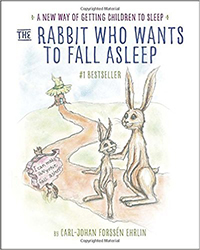The Rabbit Who Wants to Fall Asleep: A New Way of Getting Children to Sleep by C.-J. Forssen Ehrlin
DOI:
https://doi.org/10.20361/G28606Abstract
Forssen Ehrlin, Carl-Johan. The Rabbit Who Wants to Fall Asleep: A New Way of Getting Children to Sleep. Illus. Irina Maununan. New York: Crown Books for Young Readers, 2014. Print.
Carl-Johan Forssen Ehrlin, the psychologist who wrote this book, introduces the work with instructions for its calm, slow, emphatic reading. He then begins the bedtime story proper, a ten page text in which he uses the word sleep or one of its variants (asleep, sleeping, sleepy) approximately 100 times. It may be that he uses the words “yawn,” “tired,” and “relax” just as frequently; frankly, it seems too daunting a task to count and confirm this possibility. The literary effect is tedious—given the subtitle, probably intentionally so.
There is a storyline, albeit a thin one. It is much enhanced by the delicate drawings by Irina Maununen; a young child might well pore over these. However, storytelling is not the main purpose of the book. Its main purpose would appear to be hypnosis. That is just a guess; the publisher’s blurb does not actually confirm it. The blurb does, however, rave about the book’s ability to put children to sleep. Quite so.
This is not a work of children’s literature; it is a “how to” book for adults. Its advice should not replace common sense. Childhood sleeplessness can stem from serious causes. It can be the result of underlying medical conditions, of pain, of breathing difficulties. It can indicate worrisome psychological states: stress, anxiety, and fear. It can be the result of a socio-economic environment that is typified by deprivation and hunger, domestic instability, the presence of danger. A book outlining hypnotic techniques does not obviate any of these root causes of sleeplessness. However, in the event that they are all ruled out or remedied, and that a child is found to suffer from nothing more than a deep need for the comforting presence of a loving adult as he or she falls asleep, why not just ensure that one can be there?
All this being said, the book is currently popular. As I write this review, my public library lists thirty holds on fourteen copies of it. Many parents must be waiting in line for an introduction to Forssen-Ehrlin’s methods. Meanwhile, the old standbys of sleep induction, the rocking, the reassuring, the crooning of lullabies, might just prove equally effective as his book.
Not Recommended
Reviewer: Leslie Aitken
Leslie Aitken’s long career in librarianship involved selection of children’s literature for school, public, special and academic libraries. She is a former Curriculum Librarian of the University of Alberta.

Published
How to Cite
Issue
Section
License
Authors who publish with this journal agree to the following terms:
- Authors retain copyright and grant the journal right of first publication with the work simultaneously licensed under a Creative Commons Attribution License that allows others to share the work with an acknowledgement of the work's authorship and initial publication in this journal.
- Authors are able to enter into separate, additional contractual arrangements for the non-exclusive distribution of the journal's published version of the work (e.g., post it to an institutional repository or publish it in a book), with an acknowledgement of its initial publication in this journal.
- Authors are permitted and encouraged to post their work online (e.g., in institutional repositories or on their website) prior to and during the submission process, as it can lead to productive exchanges, as well as earlier and greater citation of published work (See The Effect of Open Access).






